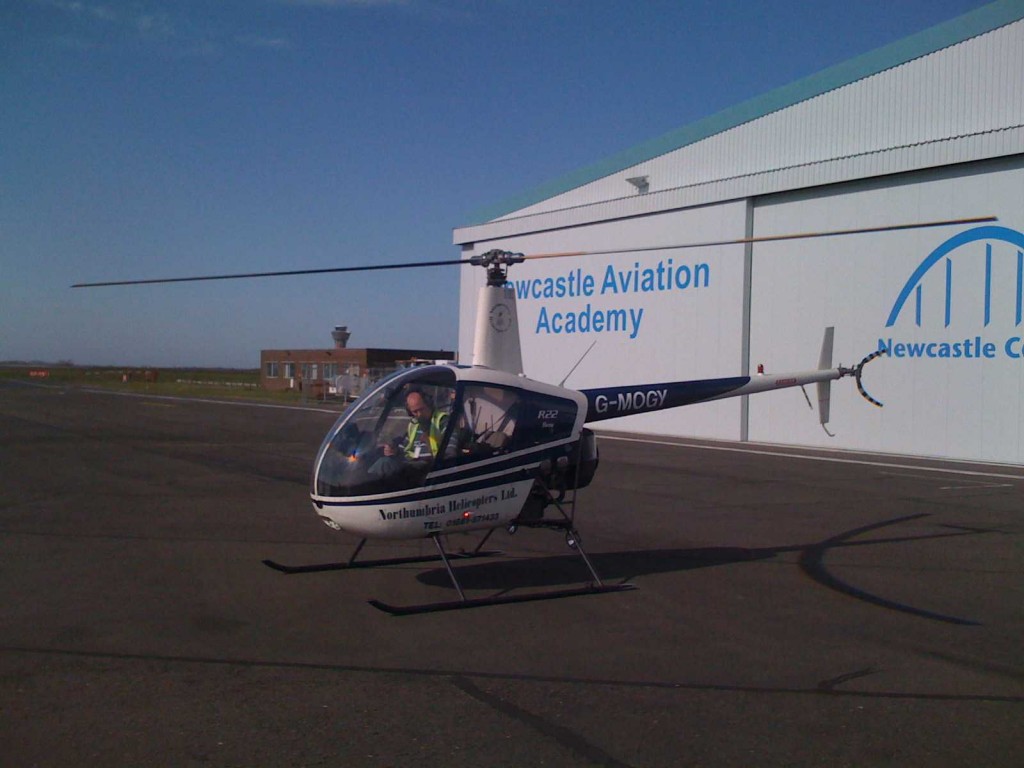Autorotations today, but me doing them. Not the full thing down to the ground, just entering autorotations and holding them with correct rotor speed down to 500 feet and then we carry on flying normally.
I am now doing all the R/T as a matter of course, plus all the initial checks, including starting the helicopter up, shutting it down etc…..
Steve does all the low level stuff, hover taxi’ing, takeoff/landings, and I do everything else (the easy bits).
Today, we were number 2 for departure after a Cessna Citation and we were asked to take off immediately heading due north from the taxiway, which took us within 200 feet of the Emirates Tower at Newcastle. That was great, you could see all the controllers. I was tempted to give them a wave, but Steve would have not been happy with me taking my hand off the collective ![]()
Off we flew, north, past Morpeth. Absolutely gorgeous day, despite predictions of potentially gusty weather. Very calm ! Calmest it’s been.
So, autorotations. I flew us upto 2000′ and then we do HASEL checks (Height, Area, Security, Engine, Lookout), and then for the first one, I follow him through doing the whole thing first to get a feel for it. So, then we do another one, and I did the cyclic only. As soon as you have no lift from the engine, the nose drops and you need to pull back on the cyclic to maintain a 60knot speed. Then back upto 2000′ again, this time, I was doing the Yaw pedals. Without the torque from the engine, the helicopter veers a lot to the left so right pedal was needed to counte this and keep us in straight balanced flight.
Then repeat again, but with me doing all 3. I did it twice in total. On one of them (the first one I think), I let the rotor rotate too fast, but generally found entering an autoration straightforward(ish). Of course, if the engine ever did go, I’d need to instinctively do the maneuvre, PLUS find somewhere to land and land it, so this bit SHOULD be the easiest bit and should be stress-free because there’d be more to worry about should I ever need it.
I asked Steve, if he’d ever had to do a real one (and he has been flying heli’s for about 1300 hours I think) and he has NEVER had to do one for real. Reassuring !!! The R22 Beta has an AvcoLyoming engine and from what I have read, they seem incredibly reliable !!
To top off the autorotation lesson, Steve did a full one, all the way down to land, which was very impressive. We aren’t allowed to land away from a licensed airfield during training, so he could do everything apart from the final touchdown but I got the idea ![]()
Once he had it in a hover, he handed it over to me to do some more hover practice. It was “ok”. I was better than my first attempts, but not much improved on the great day of hover I had in Lesson 2 or 3. But, it could have been worse. Still needing Steve to save our lives when the hover was lost !
After the hover practice, we do a lookout to check we’re ok to transition to forward/climbing flight and lucky we did, as a pair of Harrier’s flew directly over us – exciting stuff. Could hear the roar through all the rotor noise and the headsets !!! I asked Steve if they often do that, and he said they often use us as target practice – GULP ! I wasn’t sure if he was serious or not. And I’ve had another experience with them in a later lesson (Lesson 8), so I think he may be telling the truth.
Flew back and arrived back in the vicinity of the airport at rush hour (5pm) and we’re greeted by some queuing. Couple of flights queuing for takeoff and a couple coming into land PLUS us. And the added stress that Marky Mark (the local eye in the sky) wanted our heli to do his commentary on traffic asap. The tower asked us to do orbits over the golf course, which I did, but kept slackening off on the speed every once in a while. After a while of going round in circles (orbits), it gets a bit dizzying, so Steve put us into a hover at 1000′ and that was much easier and allowed us to watch the takeoff/landings from a great vantage point ![]()
I found the hover much easier to keep at this height, but probably because you can’t tell how bad the hover is ‘cos of the height you’re at !! ![]()
Here’s Marky Mark getting ready to life off……Notice the tail rotor. It’s a straight line, but it appears bent because of the speed it’s rotating….

